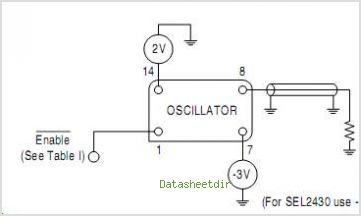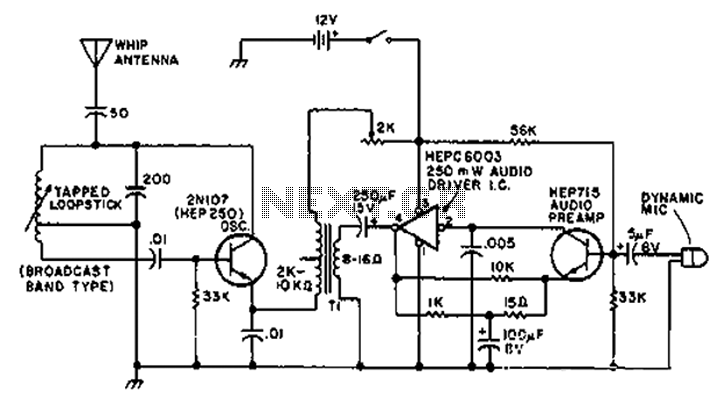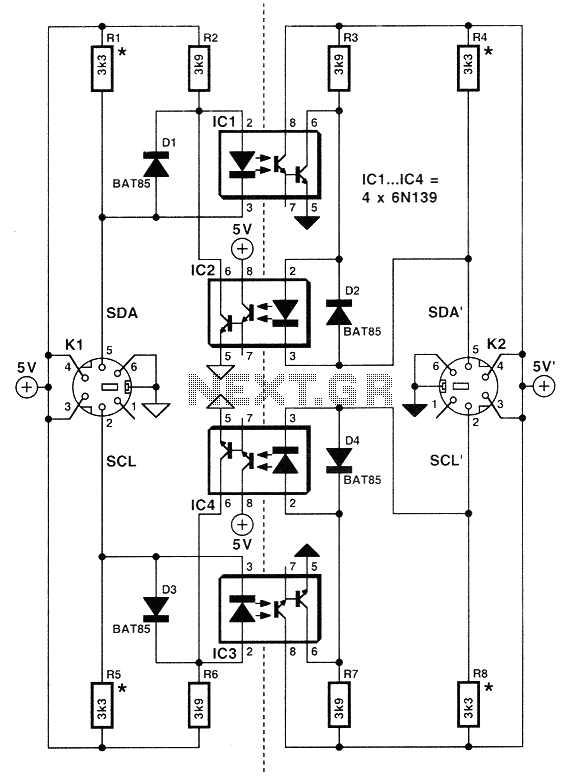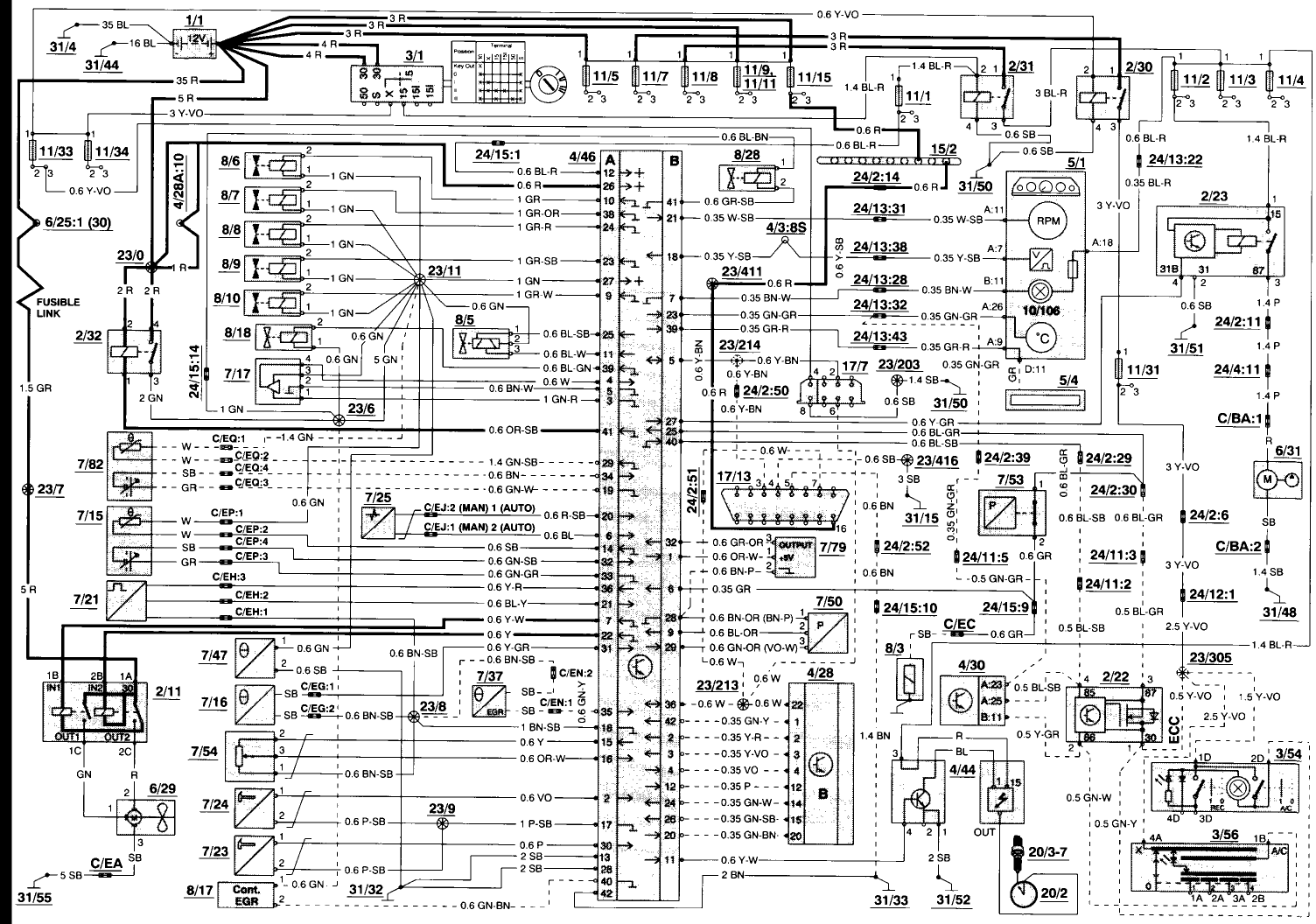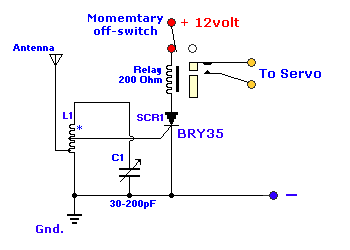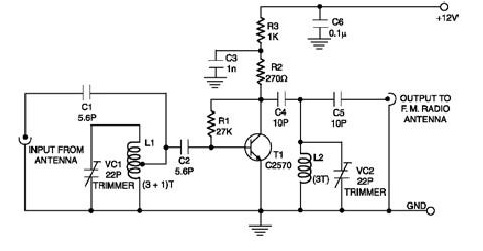
Coupler Crystal Radio
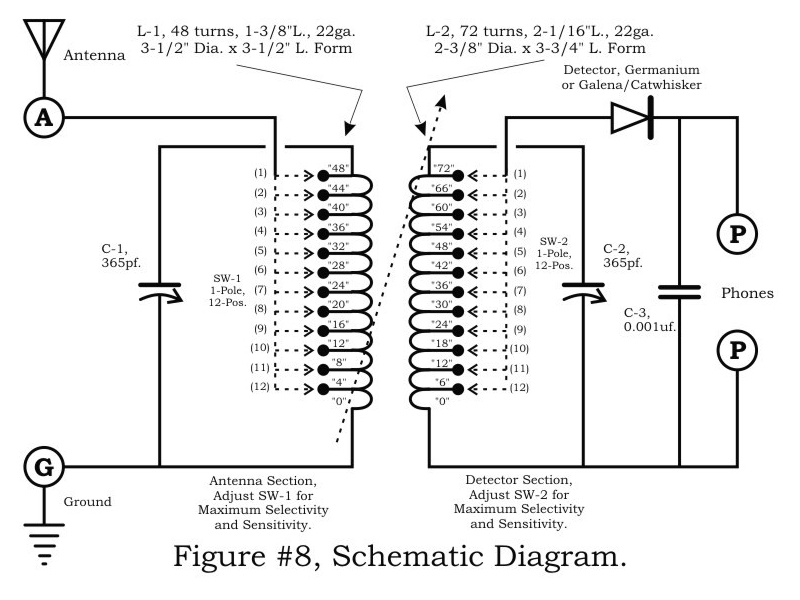
A two-circuit tuner, similar to a loose coupler, is an effective method for achieving selectivity without compromising sensitivity. The circuit introduces the signal to the primary antenna section via the SW-1 arrangement, allowing the antenna to be matched to the circuit using 12 taps on Coil L-1. Coil L-1 is tuned with a 365-variable capacitor across its entire length. The secondary detector section, L-2, consists of a moving coil that is designed to slide in and out of the primary coil. The secondary coil is mechanically arranged on a slider device, which is actuated by a horizontal screw mechanism. Coil L-2 is also tuned with another 365-variable capacitor and features an additional 12 taps leading to the detector/phones section. In summary, the two tuned coils, each with 12 taps and variable coupling capabilities, provide the receiver with exceptional versatility in station separation. The winding and construction of the coils require careful attention and can be time-consuming. The primary coil, L-1, is wound on a 3.5-inch I.D. x 3.5-inch piece of ABS pipe, with taps every fourth turn located on the inside of the coil. Tap wires should be left long enough to connect to a rotary switch mounted at the end of the coil, and the taps should be secured with hot glue to minimize interference with the sliding of L-2. It is crucial that both coils are wound in the same direction and that the ground ends match each coil arrangement. L-2 is constructed similarly, using a 2-inch I.D. x 3.75-inch piece of ABS pipe. Each coil is made with 22-gauge magnet wire, with tap points evenly divided for each coil. The mechanics of the coil/slider assembly are illustrated in Figures 1 through 4. This assembly can be used independently for other applications, such as an antenna tuner. The lead screw for moving the secondary coil is designed for precision adjustment, with a wooden toy wheel serving as the crank handle. The lead screw should be secured with locking nuts to ensure smooth operation. For testing the circuit, connect a reliable antenna and ground, set the switches to position #6, and adjust the secondary coil until it begins to engage with the primary. Connect headphones to the terminals and use a quality diode as the detector. Set the antenna variable to mid-range and gradually adjust the detector tuning to identify stations. Moving the secondary coil further into the primary increases volume while decreasing sensitivity. The detector-select switch modulates volume, with higher settings increasing volume and lower settings decreasing it. The same principle applies to the antenna switch, and experience will yield optimal settings based on antenna, ground, and environmental conditions.
The two-circuit tuner circuit design effectively demonstrates the principles of selectivity and sensitivity in radio reception. The architecture allows for fine-tuning through the use of variable capacitors and multiple taps on each coil, enhancing the user's ability to isolate specific frequencies. The use of ABS pipe for coil construction ensures durability while maintaining a lightweight structure. The choice of 22-gauge magnet wire is appropriate for minimizing resistance and ensuring efficient signal transfer.
The mechanical arrangement of the slider device for the secondary coil is a notable feature, promoting ease of adjustment and precision in tuning. The horizontal screw mechanism allows for incremental adjustments, which are critical for achieving optimal reception. The design encourages the user to engage with the tuning process actively, fostering a deeper understanding of radio frequency manipulation.
Furthermore, the inclusion of locking nuts for the lead screw enhances operational stability, preventing unintended movement during adjustments. The overall layout of the circuit, including the strategic placement of components and the systematic arrangement of taps, reflects a thoughtful approach to circuit design that prioritizes functionality and user experience.
In practical application, the tuner is versatile enough to be integrated into various radio sets or used independently, making it a valuable tool for amateur radio enthusiasts and professionals alike. The detailed instructions for assembly and testing provide a comprehensive guide for users, ensuring successful implementation and operation of the circuit. This design exemplifies the balance between complexity and usability, making it an exemplary model in the field of radio engineering.A two-circuit tuner, as the loose coupler, is one of the only ways selectivity can be accomplished without sacrificing sensitivity. Let`s look at the circuit, see figure #8: The signal is introduced to the primary antenna section via SW-1 arrangement, in which the antenna can be matched to the circuit with 12 taps on Coil L-1.
Coil L-1 is also tuned with the 365 variable across the entire L-1, which is a stationery coil. The secondary detector section, L-2 is a moving coil designed to slide in and out of the primary coil. See Figure #1 & #2 and you`ll note that the secondary coil is mechanically arranged on a slider device, which is moved by a horizontal screw arrangement.
The coil L-2 is also tuned by another 365 variable and another 12 taps to the detector/phones section. To summarize: The two tuned coils with 12 taps each and the variable coupling ability, give this receiver an extreme versatility in it`s ability to separate stations.
Winding and constructing the coils is quite time consuming and important to be correct. The primary, L-1 is wound on a 3 I. D. x 3-1/2 piece of ABS pipe. The 12 taps are every 4th. Turn and are on the inside of the coil. Leave the tap wires long enough to terminate to the rotary switch, which mounts at the end of the coil. I secured the taps, toward the switch-end of the coil with hot glue. It is important that the taps run along the wall of the inside of the coil form, to minimize interference with L-2 sliding in-and-out.
Make certain that both coils are wound in the same direction and that the ground-end matches each coil arrangement. L-2 is wound on a 2 I. D. x 3-3/4 piece of ABS pipe and constructed in the same manner as L-1. Each coil is wound with 22-gauge magnet wire and divides the taps points equally, for each coil. See figure`s # 1 through 4, which illustrates the mechanics of the coil/slider assembly. This assembly can be used independently of the entire set if you desire to use on another set, or simply for an antenna tuner.
I thought the lead-screw for moving the secondary was a nice twist and when testing the set, found it to be useful as this setting can be quite critical, at times. The handle on the lead-screw is a wooden toy wheel with an axle pin for the crank handle. The two nuts that secure the lead-screw under the primary coil should be locking nuts and adjusted sot the screw moves freely.
Testing the circuit: Connect a good antenna and ground, set the switches at position #6 and move the secondary towards the primary so it is just beginning to move inside. Connect a good set of phones to the phones terminals and use your best diode for the detector. Set the antenna variable to mid-range and slowly rote the detector tuning, denoting the stations heard.
Moving the secondary coil further into the secondary will increase the volume and decrease the sensitivity. The detector-select switch will increase the volume towards #1 and decrease toward #12. The same applies to the antenna switch and practice will show the best settings for your antenna/ground and area situations.
Have Fun, and until next time! Mike. 🔗 External reference
The two-circuit tuner circuit design effectively demonstrates the principles of selectivity and sensitivity in radio reception. The architecture allows for fine-tuning through the use of variable capacitors and multiple taps on each coil, enhancing the user's ability to isolate specific frequencies. The use of ABS pipe for coil construction ensures durability while maintaining a lightweight structure. The choice of 22-gauge magnet wire is appropriate for minimizing resistance and ensuring efficient signal transfer.
The mechanical arrangement of the slider device for the secondary coil is a notable feature, promoting ease of adjustment and precision in tuning. The horizontal screw mechanism allows for incremental adjustments, which are critical for achieving optimal reception. The design encourages the user to engage with the tuning process actively, fostering a deeper understanding of radio frequency manipulation.
Furthermore, the inclusion of locking nuts for the lead screw enhances operational stability, preventing unintended movement during adjustments. The overall layout of the circuit, including the strategic placement of components and the systematic arrangement of taps, reflects a thoughtful approach to circuit design that prioritizes functionality and user experience.
In practical application, the tuner is versatile enough to be integrated into various radio sets or used independently, making it a valuable tool for amateur radio enthusiasts and professionals alike. The detailed instructions for assembly and testing provide a comprehensive guide for users, ensuring successful implementation and operation of the circuit. This design exemplifies the balance between complexity and usability, making it an exemplary model in the field of radio engineering.A two-circuit tuner, as the loose coupler, is one of the only ways selectivity can be accomplished without sacrificing sensitivity. Let`s look at the circuit, see figure #8: The signal is introduced to the primary antenna section via SW-1 arrangement, in which the antenna can be matched to the circuit with 12 taps on Coil L-1.
Coil L-1 is also tuned with the 365 variable across the entire L-1, which is a stationery coil. The secondary detector section, L-2 is a moving coil designed to slide in and out of the primary coil. See Figure #1 & #2 and you`ll note that the secondary coil is mechanically arranged on a slider device, which is moved by a horizontal screw arrangement.
The coil L-2 is also tuned by another 365 variable and another 12 taps to the detector/phones section. To summarize: The two tuned coils with 12 taps each and the variable coupling ability, give this receiver an extreme versatility in it`s ability to separate stations.
Winding and constructing the coils is quite time consuming and important to be correct. The primary, L-1 is wound on a 3 I. D. x 3-1/2 piece of ABS pipe. The 12 taps are every 4th. Turn and are on the inside of the coil. Leave the tap wires long enough to terminate to the rotary switch, which mounts at the end of the coil. I secured the taps, toward the switch-end of the coil with hot glue. It is important that the taps run along the wall of the inside of the coil form, to minimize interference with L-2 sliding in-and-out.
Make certain that both coils are wound in the same direction and that the ground-end matches each coil arrangement. L-2 is wound on a 2 I. D. x 3-3/4 piece of ABS pipe and constructed in the same manner as L-1. Each coil is wound with 22-gauge magnet wire and divides the taps points equally, for each coil. See figure`s # 1 through 4, which illustrates the mechanics of the coil/slider assembly. This assembly can be used independently of the entire set if you desire to use on another set, or simply for an antenna tuner.
I thought the lead-screw for moving the secondary was a nice twist and when testing the set, found it to be useful as this setting can be quite critical, at times. The handle on the lead-screw is a wooden toy wheel with an axle pin for the crank handle. The two nuts that secure the lead-screw under the primary coil should be locking nuts and adjusted sot the screw moves freely.
Testing the circuit: Connect a good antenna and ground, set the switches at position #6 and move the secondary towards the primary so it is just beginning to move inside. Connect a good set of phones to the phones terminals and use your best diode for the detector. Set the antenna variable to mid-range and slowly rote the detector tuning, denoting the stations heard.
Moving the secondary coil further into the secondary will increase the volume and decrease the sensitivity. The detector-select switch will increase the volume towards #1 and decrease toward #12. The same applies to the antenna switch and practice will show the best settings for your antenna/ground and area situations.
Have Fun, and until next time! Mike. 🔗 External reference
